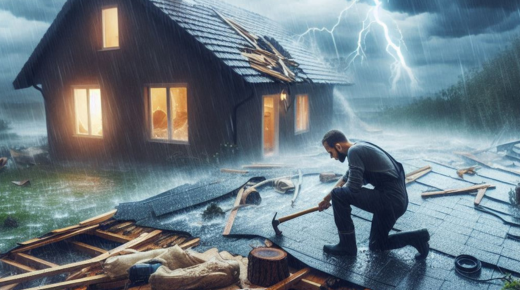When a storm hits, the impact on your home can be significant, especially when it comes to your roof. In New Jersey, where severe weather can include heavy rain, hail, and strong winds, understanding how to address storm damage is crucial for homeowners. This post aims to guide you through the essential steps to take when dealing with roof repair after a storm.
Understanding Storm Damage
Storm damage to your roof can manifest in various ways. Common signs include missing shingles, leaks, and structural issues. It’s important to conduct a thorough inspection of your roof after a storm to identify any potential problems. However, safety should always come first—if it’s not safe to access your roof, hire a professional to do the inspection.
Types of Storm Damage
- Wind Damage: High winds can lift shingles, causing them to become loose or even blow them off entirely. This exposure can lead to leaks and further deterioration of your roof.
- Hail Damage: Hail can cause dents in shingles, leading to cracks that allow water to seep in. Even minor hail damage can compromise your roof’s integrity.
- Water Damage: Heavy rains can lead to leaks, especially if your roof has existing vulnerabilities. Look for water stains on your ceilings and walls, which may indicate a roof leak.
- Structural Damage: Severe storms can cause more than just superficial damage. In extreme cases, the underlying structure of your roof may be compromised, requiring extensive repairs or a full replacement.
Assessing the Damage
After a storm, it’s essential to assess the damage quickly. Here are the steps you should take:
- Conduct a Visual Inspection: Safely inspect your roof from the ground using binoculars. Look for missing or damaged shingles, sagging areas, and any debris that may have fallen.
- Check for Interior Leaks: Inspect your attic and ceilings for water stains or signs of leakage. This can help you pinpoint areas needing immediate attention.
- Document the Damage: Take photos of any visible damage for your records and for insurance purposes. Detailed documentation can help streamline your claims process.
- Hire a Professional: If you suspect significant damage, contact a qualified roofing contractor. Professionals can provide a comprehensive assessment and recommend the best course of action.
Insurance Considerations
After assessing the damage, your next step is to contact your insurance company. Many homeowners in NJ have coverage for storm-related roof damage, but it’s crucial to understand your policy’s specifics. Here are some tips:
- Review Your Policy: Familiarize yourself with your coverage limits and the types of damage that are included. Most policies cover sudden and accidental damage, but exclusions can vary.
- File a Claim Promptly: Report the damage to your insurance company as soon as possible. Provide them with the documentation and photos you collected.
- Be Prepared for an Adjuster Visit: An insurance adjuster may need to inspect the damage before approving your claim. Be present during the inspection to provide any additional information.
- Understand Your Deductible: Be aware of your deductible, as this is the amount you’ll need to pay out of pocket before your insurance kicks in.
Choosing a Roofing Contractor
Finding the right roof storm damage repair NJ is critical for ensuring that repairs are done correctly and safely. Here are some tips for choosing a reputable contractor in NJ:
- Check Credentials: Ensure the contractor is licensed and insured. This protects you from liability if an accident occurs during repairs.
- Look for Experience: Choose a contractor with experience in storm damage repairs. They’ll be more familiar with the specific challenges that come with this type of work.
- Read Reviews: Look for online reviews and testimonials from previous customers. This can provide insight into the contractor’s reliability and quality of work.
- Get Multiple Estimates: Don’t settle for the first estimate you receive. Obtain quotes from several contractors to compare prices and services.
- Ask for References: A reputable contractor should be willing to provide references. Reach out to previous clients to inquire about their experiences.
Repairing vs. Replacing Your Roof
Once the damage has been assessed, you’ll need to decide whether to roof repair NJ or replace your roof. Several factors will influence this decision:
- Extent of Damage: If only a few shingles are missing, a repair may suffice. However, if the damage is widespread or the roof is nearing the end of its lifespan, a full replacement may be necessary.
- Age of the Roof: If your roof is older and has sustained multiple repairs, it may be more cost-effective to replace it rather than continue patching it.
- Cost Considerations: Weigh the cost of repairs against the long-term investment of a new roof. In some cases, a new roof may offer better energy efficiency and durability.
Final Thoughts
Dealing with storm damage to your roof can be overwhelming, but understanding the steps to take can help ease the process. From assessing the damage to working with your insurance and choosing a reputable contractor, being informed will empower you to make the best decisions for your home. Don’t hesitate to seek professional assistance—your roof is a vital part of your home’s structure, and timely repairs can save you from more extensive damage down the line. Stay proactive, and ensure your home is protected against the elements!

